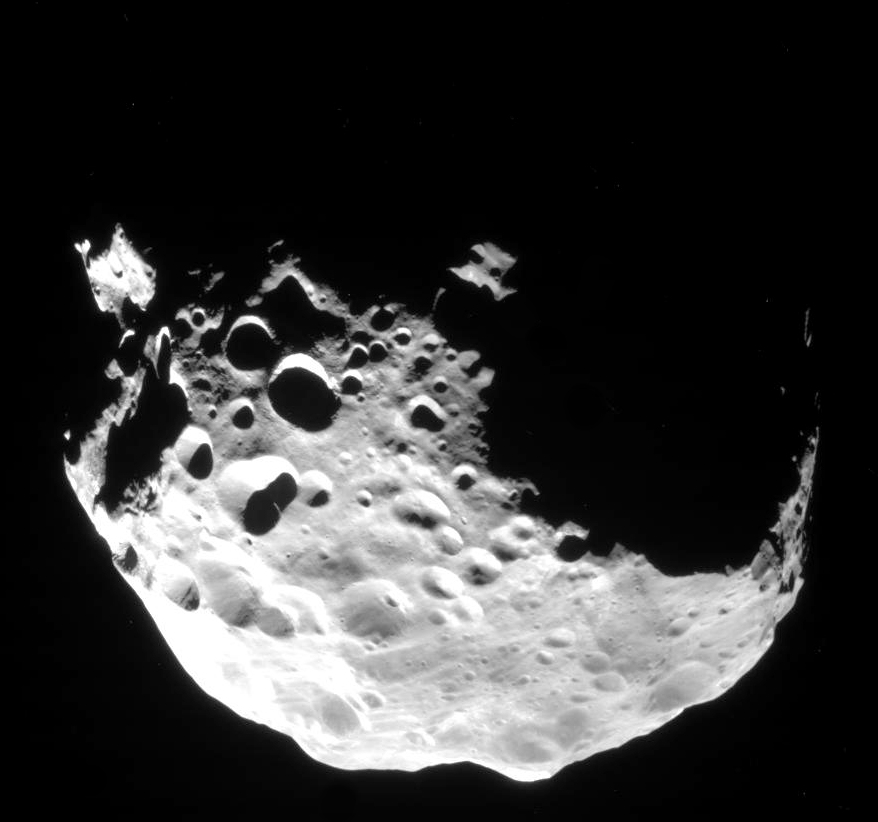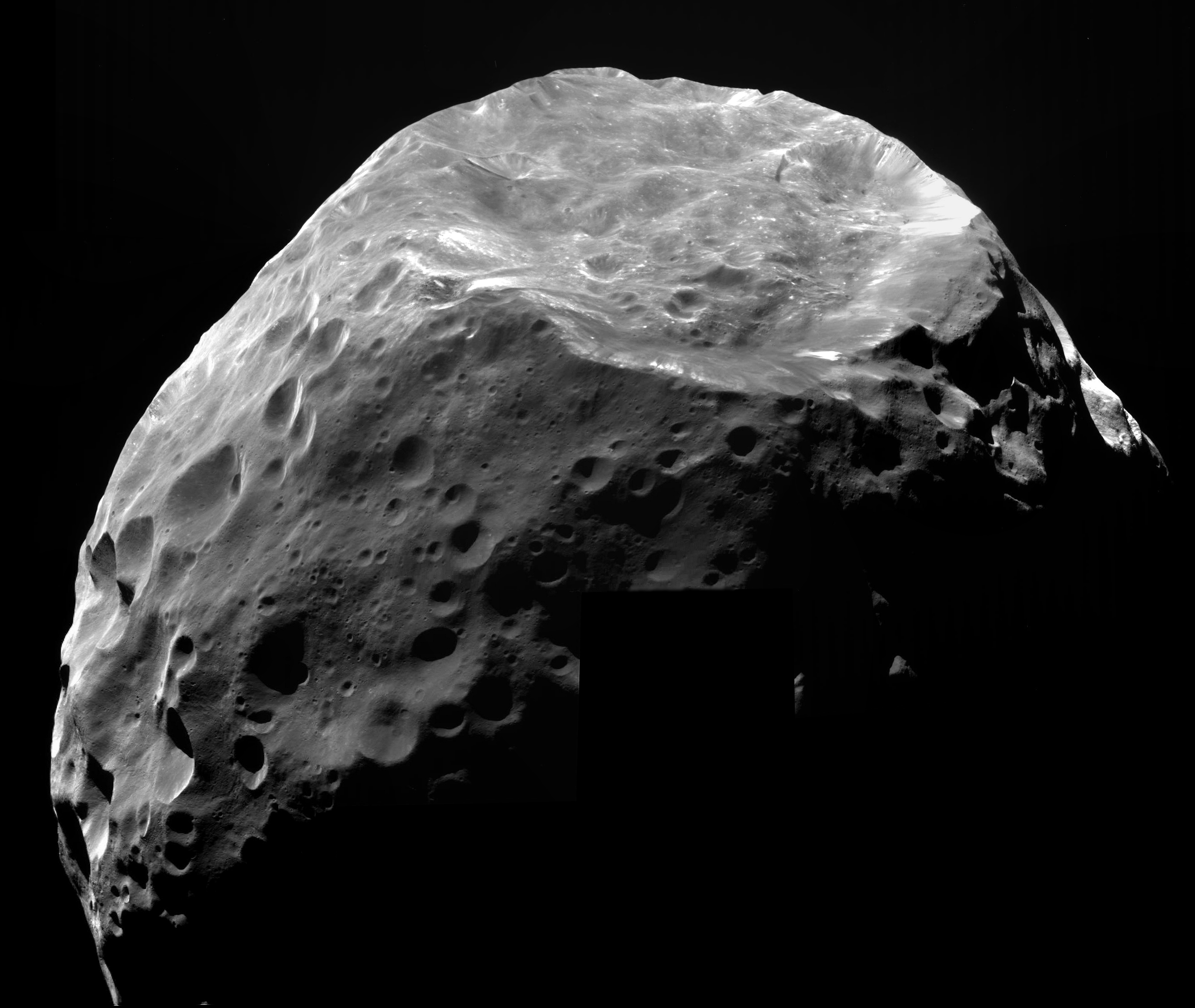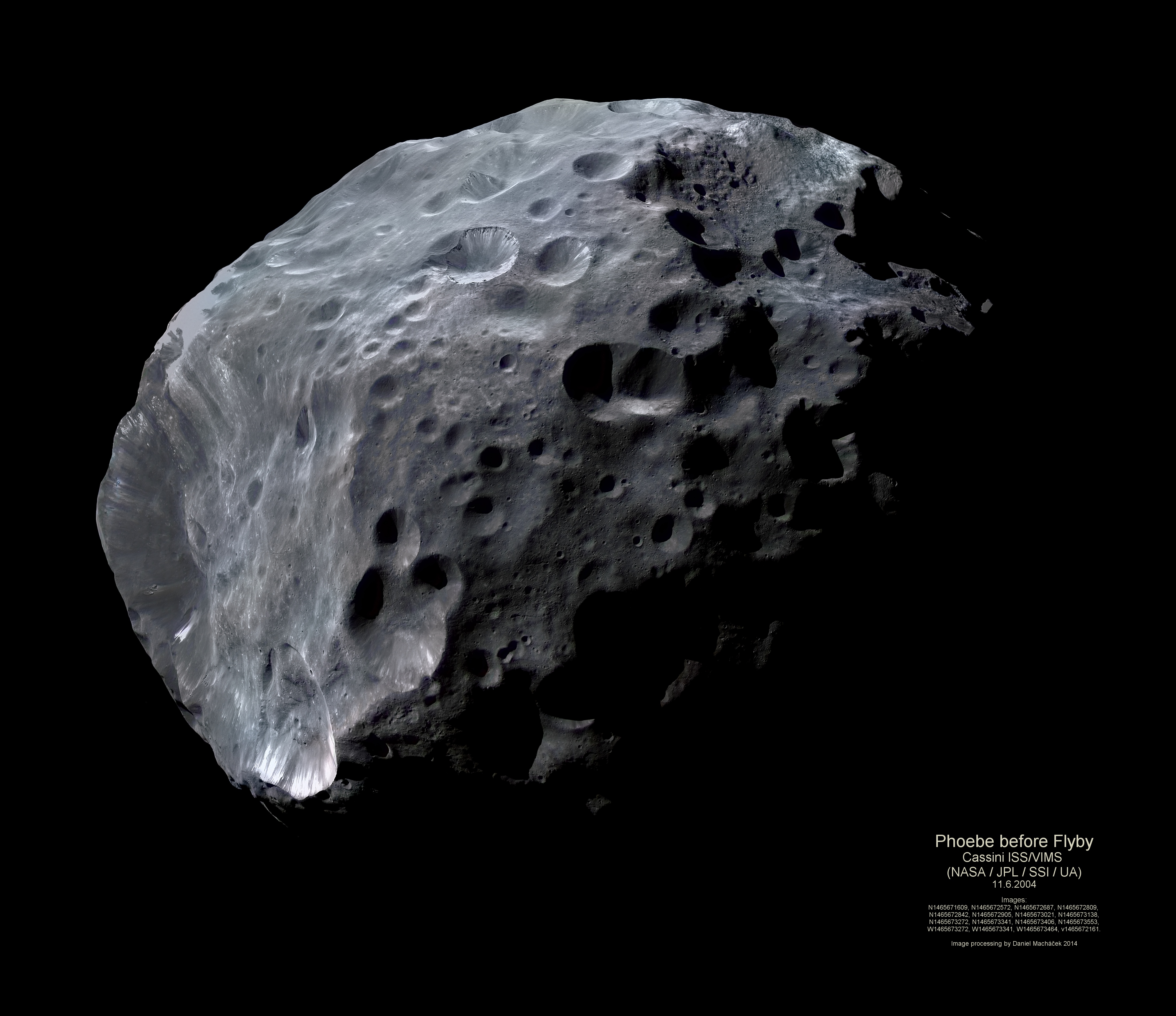It looks like you're using an Ad Blocker.
Please white-list or disable AboveTopSecret.com in your ad-blocking tool.
Thank you.
Some features of ATS will be disabled while you continue to use an ad-blocker.
24
share:
Phoebe!

Discovered by William Henry Pickering on 17 March 1899 from photographic plates (and being the first satellite to be discovered photographically), it is an irregular satellite of Saturn a little over 200 km in diameter.

Phoebe is truly an odd one among her "friends":
For several reasons, Phoebe is thought to be a captured object that does not share a joint origin with Saturn and the inner, "regular" satellites. It orbits in a retrograde direction, opposite to the direction of Saturn's other major moons. Its overall density was determined by Cassini scientists to be quite large for a moon of Saturn. The prevailing view is that Phoebe might have formed in the Kuiper Belt, far beyond the orbit of Saturn. It might thus be a small cousin of the largest Kuiper Belt object, Pluto.
Most of Saturn's inner moons have very bright surfaces, but Phoebe's albedo is very low (0.06), slightly brighter than fresh asphalt or charcoal. However, it is believed that underneath that dark surface, there is water ice.
NASA's spacecraft Cassini took some closeups of Phoebe on its way to the orbit around Saturn. These are the closest and most detailed images we have of this moon. Since then, Cassini has been orbiting close to Saturn and never close enough to Phoebe to take such pictures again.
Here's a mosaic I made from Cassini's raw images during that fly-by:

Full-sized version: www.pictureshack.us...
NASA article: saturn.jpl.nasa.gov...
Phil Plait's blog: www.slate.com...
Daniel Macháček managed to create colour mosaics of Phoebe, using data from Cassini's Visual and Infrared Mapping Spectrometer (VIMS):


Discovered by William Henry Pickering on 17 March 1899 from photographic plates (and being the first satellite to be discovered photographically), it is an irregular satellite of Saturn a little over 200 km in diameter.

Phoebe is truly an odd one among her "friends":
For several reasons, Phoebe is thought to be a captured object that does not share a joint origin with Saturn and the inner, "regular" satellites. It orbits in a retrograde direction, opposite to the direction of Saturn's other major moons. Its overall density was determined by Cassini scientists to be quite large for a moon of Saturn. The prevailing view is that Phoebe might have formed in the Kuiper Belt, far beyond the orbit of Saturn. It might thus be a small cousin of the largest Kuiper Belt object, Pluto.
Most of Saturn's inner moons have very bright surfaces, but Phoebe's albedo is very low (0.06), slightly brighter than fresh asphalt or charcoal. However, it is believed that underneath that dark surface, there is water ice.
NASA's spacecraft Cassini took some closeups of Phoebe on its way to the orbit around Saturn. These are the closest and most detailed images we have of this moon. Since then, Cassini has been orbiting close to Saturn and never close enough to Phoebe to take such pictures again.
Here's a mosaic I made from Cassini's raw images during that fly-by:

Full-sized version: www.pictureshack.us...
NASA article: saturn.jpl.nasa.gov...
Phil Plait's blog: www.slate.com...
Daniel Macháček managed to create colour mosaics of Phoebe, using data from Cassini's Visual and Infrared Mapping Spectrometer (VIMS):

edit on 16-6-2014 by wildespace because: (no reason given)
I prefer the one with the cape, but nice post, interesting picture. Star and Flag.
a reply to: wildespace
This thing is just like Mars in my view full of anomalies.
Maybe I will post some of it later gotta go now.
2e Picture on the right side the illuminated part.
Take the Pictureshack link and download.
Thx for posting .., i love to take these pics apart.
This thing is just like Mars in my view full of anomalies.
Maybe I will post some of it later gotta go now.
2e Picture on the right side the illuminated part.
Take the Pictureshack link and download.
Thx for posting .., i love to take these pics apart.
I'll bet that the big missing chunk fom Phoebe is probably from when it suffered a collision with another body in the Kuiper belt, hence hurling it
towards Saturn.
Love imagining these things!
Love imagining these things!
I love checking the recents so that I stay up to date with everything on ats. I must say this was the most excited ';ve been for a recent post in a
bit. I love that you do these and break them up instead of creating one huge mega thread. Always interesting and very informative.a reply to:
wildespace
Thanks for the photos and history OPSure is an odd duck but MAY have life sustaining water on it.Interesting.
a reply to: wildespace
S&f...I am always interesting in new information to increase our knowledge to our celestial neighbors.
Can't contribute much to your post; but nonetheless very interesting...
S&f...I am always interesting in new information to increase our knowledge to our celestial neighbors.
Can't contribute much to your post; but nonetheless very interesting...
Thanks for your feedback, I love making threads like this. There are many other "Strange Moons" threads on ATS, just do a search for them.
I made a video using my Cassini images of Saturn and some of its moons (some of which featured in the "Strange Moons" series of threads.
www.youtube.com...
Please watch full-screen and in HD.
www.youtube.com...
Please watch full-screen and in HD.
new topics
-
Jaguar Rebrand Video Causes "WTF?" Moment - Seriously Weird
Automotive Discussion: 7 minutes ago -
Let's start a conspiracy
General Conspiracies: 50 minutes ago -
What Joe Rogan said Vs The View
Dissecting Disinformation: 3 hours ago -
Biden's "Reckless" Decision To Escalate Russia-Ukraine War
World War Three: 4 hours ago
top topics
-
President-Elect TRUMP Picks Former Florida A.G. PAM BONDI to be U.S. Attorney General.
2024 Elections: 16 hours ago, 15 flags -
Biden's "Reckless" Decision To Escalate Russia-Ukraine War
World War Three: 4 hours ago, 15 flags -
What Joe Rogan said Vs The View
Dissecting Disinformation: 3 hours ago, 10 flags -
Inca stone masonry at Sacsayhuaman, Ollantaytambo and the Sun Temple
Ancient & Lost Civilizations: 12 hours ago, 6 flags -
Jaguar Rebrand Video Causes "WTF?" Moment - Seriously Weird
Automotive Discussion: 7 minutes ago, 1 flags -
Let's start a conspiracy
General Conspiracies: 50 minutes ago, 0 flags
active topics
-
-@TH3WH17ERABB17- -Q- ---TIME TO SHOW THE WORLD--- -Part- --44--
Dissecting Disinformation • 3347 • : Thoughtful3 -
Biden's "Reckless" Decision To Escalate Russia-Ukraine War
World War Three • 61 • : UpIsNowDown2 -
What Joe Rogan said Vs The View
Dissecting Disinformation • 12 • : AlroyFarms -
Jaguar Rebrand Video Causes "WTF?" Moment - Seriously Weird
Automotive Discussion • 0 • : gortex -
Well we know Putins ICBMs won't fail in their silos
World War Three • 147 • : Oldcarpy2 -
Candidate TRUMP Now Has Crazy Judge JUAN MERCHAN After Him - The Stormy Daniels Hush-Money Case.
Political Conspiracies • 2166 • : Oldcarpy2 -
Let's start a conspiracy
General Conspiracies • 3 • : UpIsNowDown2 -
Putin will warn civilians in targeted areas
World War Three • 41 • : Ravenwatcher -
President-Elect TRUMP Picks Former Florida A.G. PAM BONDI to be U.S. Attorney General.
2024 Elections • 40 • : WeMustCare -
DOJ moving to wind down Trump criminal cases before he takes office
Mainstream News • 41 • : WeMustCare
24
